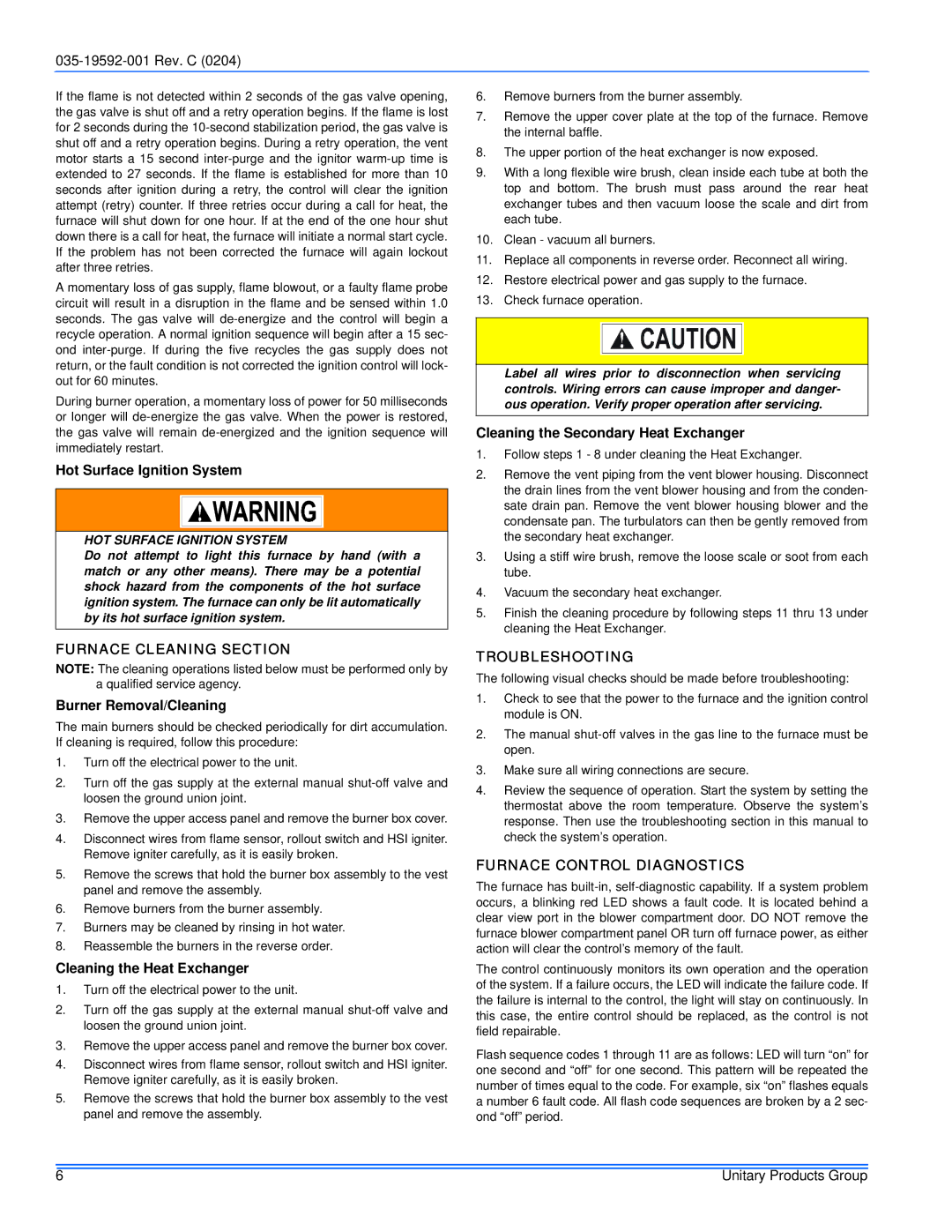
If the flame is not detected within 2 seconds of the gas valve opening, the gas valve is shut off and a retry operation begins. If the flame is lost for 2 seconds during the
A momentary loss of gas supply, flame blowout, or a faulty flame probe circuit will result in a disruption in the flame and be sensed within 1.0 seconds. The gas valve will
During burner operation, a momentary loss of power for 50 milliseconds or longer will
Hot Surface Ignition System
HOT SURFACE IGNITION SYSTEM
Do not attempt to light this furnace by hand (with a match or any other means). There may be a potential shock hazard from the components of the hot surface ignition system. The furnace can only be lit automatically by its hot surface ignition system.
FURNACE CLEANING SECTION
NOTE: The cleaning operations listed below must be performed only by a qualified service agency.
Burner Removal/Cleaning
The main burners should be checked periodically for dirt accumulation. If cleaning is required, follow this procedure:
1.Turn off the electrical power to the unit.
2.Turn off the gas supply at the external manual
3.Remove the upper access panel and remove the burner box cover.
4.Disconnect wires from flame sensor, rollout switch and HSI igniter. Remove igniter carefully, as it is easily broken.
5.Remove the screws that hold the burner box assembly to the vest panel and remove the assembly.
6.Remove burners from the burner assembly.
7.Burners may be cleaned by rinsing in hot water.
8.Reassemble the burners in the reverse order.
Cleaning the Heat Exchanger
1.Turn off the electrical power to the unit.
2.Turn off the gas supply at the external manual
3.Remove the upper access panel and remove the burner box cover.
4.Disconnect wires from flame sensor, rollout switch and HSI igniter. Remove igniter carefully, as it is easily broken.
5.Remove the screws that hold the burner box assembly to the vest panel and remove the assembly.
6.Remove burners from the burner assembly.
7.Remove the upper cover plate at the top of the furnace. Remove the internal baffle.
8.The upper portion of the heat exchanger is now exposed.
9.With a long flexible wire brush, clean inside each tube at both the top and bottom. The brush must pass around the rear heat exchanger tubes and then vacuum loose the scale and dirt from each tube.
10.Clean - vacuum all burners.
11.Replace all components in reverse order. Reconnect all wiring.
12.Restore electrical power and gas supply to the furnace.
13.Check furnace operation.
Label all wires prior to disconnection when servicing controls. Wiring errors can cause improper and danger- ous operation. Verify proper operation after servicing.
Cleaning the Secondary Heat Exchanger
1.Follow steps 1 - 8 under cleaning the Heat Exchanger.
2.Remove the vent piping from the vent blower housing. Disconnect the drain lines from the vent blower housing and from the conden- sate drain pan. Remove the vent blower housing blower and the condensate pan. The turbulators can then be gently removed from the secondary heat exchanger.
3.Using a stiff wire brush, remove the loose scale or soot from each tube.
4.Vacuum the secondary heat exchanger.
5.Finish the cleaning procedure by following steps 11 thru 13 under cleaning the Heat Exchanger.
TROUBLESHOOTING
The following visual checks should be made before troubleshooting:
1.Check to see that the power to the furnace and the ignition control module is ON.
2.The manual
3.Make sure all wiring connections are secure.
4.Review the sequence of operation. Start the system by setting the thermostat above the room temperature. Observe the system’s response. Then use the troubleshooting section in this manual to check the system’s operation.
FURNACE CONTROL DIAGNOSTICS
The furnace has
The control continuously monitors its own operation and the operation of the system. If a failure occurs, the LED will indicate the failure code. If the failure is internal to the control, the light will stay on continuously. In this case, the entire control should be replaced, as the control is not field repairable.
Flash sequence codes 1 through 11 are as follows: LED will turn “on” for one second and “off” for one second. This pattern will be repeated the number of times equal to the code. For example, six “on” flashes equals a number 6 fault code. All flash code sequences are broken by a 2 sec- ond “off” period.
6 | Unitary Products Group |
